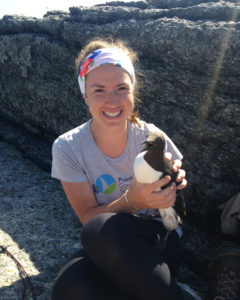Marine Biologist; Quantitative Ecologist

During her master’s research in Newfoundland, Julia deployed GPS tags on common murres to study their foraging behavior.
Julia Gulka, M.S.
Marine Biologist, Quantitative Ecologist
julia.gulka@briwildlife.org
207-839-7600
Julia works on projects related to offshore wind energy development. These projects include organizing and developing technical programs for stakeholder meetings, conducting literature reviews, making scientific recommendations based on the available literature, and conducting offshore wildlife surveys.
Julia is currently working on projects funded by the New York Energy Research and Development Authority, including a study of marine bird movement and habitat use in relation to forage fish abundance and distribution. She also provides technical support for the New York Environmental Technical Working Group, including managing work groups to identify key research priorities to better understand cumulative biological impacts from offshore wind development.
Education & Certifications
- M.Sc. Biological Sciences. University of Manitoba, Winnipeg, MB, Canada. 2018.
- B.A. Conservation Biology. Middlebury College, Middlebury, VT, USA. 2013.
Research Interests & Expertise
Research Interests
Julia is interested in marine bird movement, behavioral ecology, trophic relationships, and conservation; wildlife impacts from offshore wind
energy development; marine contaminants and plastic pollution; and marine spatial planning.
Expertise and Experience
- Extensive seabird research including:
- GPS, geolocator, and satellite tagging
- Behavioral observations
- Population censusing (point counts, transects, and occupancy counts)
- Sample collection (blood, feathers, and diet)
- Boat-based surveys for abundance and distribution
- Mist-netting and banding songbirds
- GIS analysis in R
- Hydroacoustic fish surveys
Journal Articles
Research Reports
BRI Scientific Communications
Grants, Awards & Fellowships
- Young Explorers Grant. National Geographic, 2017-2018
- Student Travel Award. American Ornithological Society Conference, 2018
- Best Student Paper Award. Pacific Seabird Group Conference, 2018, 2017
- Student Travel Award. Pacific Seabird Group Conference, 2018
- G. Vlad Presentation Award. Department of Biological Sciences, University of Manitoba, 2018
- Manitoba Graduate Scholarship. University of Manitoba, present
- University of Manitoba Graduate Fellowship. University of Manitoba, declined
- International Graduate Student Entrance Scholarship. University of Manitoba, present


